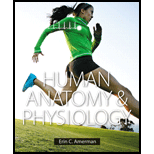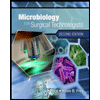
Human Anatomy & Physiology
1st Edition
ISBN: 9780805382952
Author: Erin C. Amerman
Publisher: PEARSON
expand_more
expand_more
format_list_bulleted
Concept explainers
Textbook Question
Chapter 1, Problem 2AYK
During a procedure on Ms. Norman’s pancreas, a surgeon makes the initial incision in the left anterior hypochondriac region. List all the organs, serous membranes, and body cavities that the surgeon will encounter as she moves through the body to get to the pancreas. (Hint: Refer to A&P in the Real World: Abdominal Pain on page 19 for help.)
Expert Solution & Answer
Want to see the full answer?
Check out a sample textbook solution
Students have asked these similar questions
What are biofertilizers and mention the significance
PCBs and River Otters: Otters in Washington State’s Green-Duwamish River have high levels of polychlorinated biphenyls (PCBs) in their livers. PCBs can bind to the estrogen receptors in animals and disrupt the endocrine system of these otters. The PCBs seem to increase the estrogen to androgen ratio, skewing the ratio toward too much estrogen.
How would increased estrogen affect the river otter population?
Based on your reading of the materials in this unit, what factors can affect fertility in humans?
Explain how each of the factors affecting human fertility that you described can disrupt the human endocrine system to affect reproduction.
Other than oil and alcohol, are there other liquids you could compare to water (that are liquid at room temperature)?
How is water unique compared to these other liquids?
What follow-up experiment would you like to do, and how would you relate it to your life?
Chapter 1 Solutions
Human Anatomy & Physiology
Ch. 1.1 - What are learning styles? Which learning style(S)...Ch. 1.1 - 2. How should you approach reading a textbook,...Ch. 1.1 - What are some study strategies to improve your...Ch. 1.1 - Prob. 4QCCh. 1.1 - 5. What are some strategies for taking good notes...Ch. 1.1 - 6. How can you use the features found in each...Ch. 1.1 - 7. How should you approach the study of figures...Ch. 1.1 - Design a study schedule for yourself up to the...Ch. 1.1 - 2. Determine several study strategies that will...Ch. 1.2 - List the properties common to all living...
Ch. 1.2 - Prob. 2QCCh. 1.2 - Prob. 3QCCh. 1.2 - 4. How do gross anatomy and microscopic anatomy...Ch. 1.2 - How are physiological specializations classified?Ch. 1.2 - The condition hypothyroidism is characterized by a...Ch. 1.2 - 2. At first glance, a human and a rose plant seem...Ch. 1.3 - Define anatomical position.
Ch. 1.3 - Fill in the blanks: The nose is to the mouth....Ch. 1.3 - Fill in the blanks: a. The wrist is also known as...Ch. 1.3 - Explain how the three main planes of section...Ch. 1.3 - Locate a mole, scar, tattoo, or other mark on your...Ch. 1.3 - You need to examine the internal anatomy of both...Ch. 1.4 - What are the two subcavities of the dorsal body...Ch. 1.4 - 2. List the subdivisions of the thoracic and...Ch. 1.4 - 3. What are serous membranes, and what are their...Ch. 1.4 - Explain how serous membranes form certain ventral...Ch. 1.4 - Prob. 1AWYLCh. 1.4 - Prob. 2AWYLCh. 1.4 - Inflammation of serous membranes may cause the...Ch. 1.5 - 1. What is homeostasis, and why is it important?
Ch. 1.5 - 2. What is a homeostatic imbalance?
Ch. 1.5 - How do negative feedback loops maintain...Ch. 1.5 - Prob. 4QCCh. 1.5 - Prob. 5QCCh. 1.5 - 6. Define gradient, and give examples of different...Ch. 1.5 - 7. Why is cell-cell communication important?
Ch. 1.5 - 8. What are the two major methods by which cells...Ch. 1.5 - The cells of cancerous tumors undergo changes that...Ch. 1.5 - Prob. 2AWYLCh. 1.5 - 3. You plug in an electric air freshener and...Ch. 1 - Fill in the blanks: The study of the form of the...Ch. 1 - 2. Mark the following statements as true or false....Ch. 1 - Prob. 3CYRCh. 1 - 4. Which of the following resources does the book...Ch. 1 - Prob. 5CYRCh. 1 - 5. Which of the following correctly describes the...Ch. 1 - Mark the following statements as true or false. If...Ch. 1 - Match the following terms with the correct...Ch. 1 - 8. The upper and lower limbs are known broadly as...Ch. 1 - The arm is known as the ___________ region; the...Ch. 1 - A parasagittal section divides the body or body...Ch. 1 - 11. Fill in the blanks: The two divisions of the...Ch. 1 - 12. Fill in the blanks: The two main divisions of...Ch. 1 - 13. In which of the following cavities do serous...Ch. 1 - 14. Serous fluid functions in:
a. Providing...Ch. 1 - 15. Which organs would you expect to find in the...Ch. 1 - 16. Mark the following statements as true or...Ch. 1 - Prob. 18CYRCh. 1 - Examine the structure of the skull, and predict...Ch. 1 - Prob. 2CYUCh. 1 - Prob. 1AYKCh. 1 - 2. During a procedure on Ms. Norman’s pancreas, a...Ch. 1 - Later that same day, the surgeon performs a...Ch. 1 - The baroreceptor reflex causes blood pressure to...
Knowledge Booster
Learn more about
Need a deep-dive on the concept behind this application? Look no further. Learn more about this topic, biology and related others by exploring similar questions and additional content below.Similar questions
- Selection of Traits What adaptations do scavengers have for locating and feeding on prey? What adaptations do predators have for capturing and consuming prey?arrow_forwardCompetition Between Species What natural processes limit populations from growing too large? What are some resources organisms can compete over in their natural habitat?arrow_forwardSpecies Interactions Explain how predators, prey and scavengers interact. Explain whether predators and scavengers are necessary or beneficial for an ecosystem.arrow_forward
- magine that you are conducting research on fruit type and seed dispersal. You submitted a paper to a peer-reviewed journal that addresses the factors that impact fruit type and seed dispersal mechanisms in plants of Central America. The editor of the journal communicates that your paper may be published if you make ‘minor revisions’ to the document. Describe two characteristics that you would expect in seeds that are dispersed by the wind. Contrast this with what you would expect for seeds that are gathered, buried or eaten by animals, and explain why they are different. (Editor’s note: Providing this information in your discussion will help readers to consider the significance of the research).arrow_forwardWhat is the difference between Uniporters, Symporters and Antiporters? Which of these are examples of active transport?arrow_forwardWhat are coupled transporters?arrow_forward
- How do histamine and prostaglandins help in the mobilization of leukocytes to an injury site? What are chemotactic factors? How do they affect inflammation process?arrow_forwardCompare and contrast neutrophils and macrophages. Describe two ways they are different and two ways they are similar.arrow_forwardDescribe the effects of three cytokines (not involved in the initial inflammation response). What cells release them?arrow_forward
arrow_back_ios
SEE MORE QUESTIONS
arrow_forward_ios
Recommended textbooks for you
 Microbiology for Surgical Technologists (MindTap ...BiologyISBN:9781111306663Author:Margaret Rodriguez, Paul PricePublisher:Cengage Learning
Microbiology for Surgical Technologists (MindTap ...BiologyISBN:9781111306663Author:Margaret Rodriguez, Paul PricePublisher:Cengage Learning Comprehensive Medical Assisting: Administrative a...NursingISBN:9781305964792Author:Wilburta Q. Lindh, Carol D. Tamparo, Barbara M. Dahl, Julie Morris, Cindy CorreaPublisher:Cengage Learning
Comprehensive Medical Assisting: Administrative a...NursingISBN:9781305964792Author:Wilburta Q. Lindh, Carol D. Tamparo, Barbara M. Dahl, Julie Morris, Cindy CorreaPublisher:Cengage Learning Medical Terminology for Health Professions, Spira...Health & NutritionISBN:9781305634350Author:Ann Ehrlich, Carol L. Schroeder, Laura Ehrlich, Katrina A. SchroederPublisher:Cengage Learning
Medical Terminology for Health Professions, Spira...Health & NutritionISBN:9781305634350Author:Ann Ehrlich, Carol L. Schroeder, Laura Ehrlich, Katrina A. SchroederPublisher:Cengage Learning



Microbiology for Surgical Technologists (MindTap ...
Biology
ISBN:9781111306663
Author:Margaret Rodriguez, Paul Price
Publisher:Cengage Learning

Comprehensive Medical Assisting: Administrative a...
Nursing
ISBN:9781305964792
Author:Wilburta Q. Lindh, Carol D. Tamparo, Barbara M. Dahl, Julie Morris, Cindy Correa
Publisher:Cengage Learning


Medical Terminology for Health Professions, Spira...
Health & Nutrition
ISBN:9781305634350
Author:Ann Ehrlich, Carol L. Schroeder, Laura Ehrlich, Katrina A. Schroeder
Publisher:Cengage Learning
Dissection Basics | Types and Tools; Author: BlueLink: University of Michigan Anatomy;https://www.youtube.com/watch?v=-_B17pTmzto;License: Standard youtube license